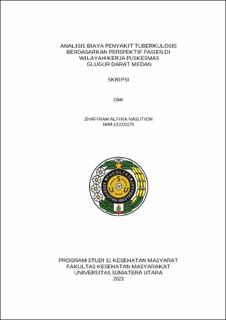| dc.description.abstract | Tuberculosis is a chronic infectious disease caused by the bacterium
Mycobacterium tuberculosis. This disease is one of the main causes of health
problems and death due to the high cost of treatment. Patients with tuberculosis
require long-term treatment to achieve recovery, prevent death, prevent
recurrence and reduce the risk of transmission. This shows that this disease
requires a high cost. Some of the non-medical costs that must be borne by patients
and their families include transportation costs to health facilities, temporary
accommodation, child care and food costs while the patient is being treated or
treated for tuberculosis. Conditions that often occur are patients delaying
treatment because the perceived costs are getting higher. This can cause the
disease to become more severe and require more expensive treatment, such as
hospitalization. These initial barriers to seeking care and the economic
consequences of hospitalization disproportionately affect individuals living in
conditions of poverty. This situation is especially severe in rural areas with
limited resources, where these costs can become a large burden on the local
community. This research is a type of descriptive quantitative research. This
research was conducted in the Working Area of the Glugur Darat Health Center.
The research sample consisted of 58 people based on calculations using the slovin
method at the research locus of the Glugur Darat Health Center. The results of
the data analysis showed that the direct non-medical costs of tuberculosis patients
amounted to Rp. 190,470 with the largest component being the cost of home care.
Indirect costs for tuberculosis patients amounted to Rp. 77,420 with the largest
cost component being the patient's lost income due to illness. The total cost of TB
patients for 6 months is IDR 1,606,980 with an average of IDR 267,890 per
month. Therefore it is hoped that the puskesmas as a community health service
center will be more proactive in providing health services outside the building by
increasing promotive and preventive services to the community | en_US |


